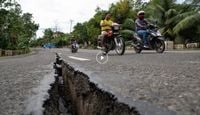On the night of September 30, 2025, a powerful magnitude 6.9 earthquake struck the central Philippine province of Cebu, sending shockwaves through the region and leaving a trail of devastation in its wake. The quake, which hit at approximately 9:59 p.m. local time, was centered off the coast near Bogo City, situated on the northern tip of Cebu Island. According to official reports cited by Reuters and other reputable outlets, at least 69 people lost their lives, making it the deadliest earthquake in the Philippines since 2013. Nearly 150 others sustained injuries, many of them trauma and crush injuries, as buildings collapsed and debris rained down in the chaos.
As the ground shook violently, dashcam and CCTV footage captured harrowing scenes: riders thrown from motorcycles, families fleeing their homes, and the iconic Mactan-Mandaue bridge swaying so fiercely that motorcyclists abandoned their scooters to cling to railings for safety. The quake, described by the Philippine Institute of Volcanology and Seismology (PHIVOLCS) as shallow and close to the coast, intensified the destruction, disrupting power and communication lines across northern Cebu and sending people running in panic into the streets. According to The Guardian, houses, nightclubs, and other businesses crumbled, while a historic stone church suffered significant damage.
Local governments in Bogo, San Remigio, Tabuelan, and Medellin swiftly declared a state of calamity, as these areas bore the brunt of the disaster. Emergency shelters opened their doors to displaced families, and aid agencies rushed to deliver food, water, and portable generators. Schools and offices in the affected areas suspended operations, and engineers began inspecting buildings for structural safety amid widespread reports of cracks and partial collapses. Airports managed to remain operational, but ferry services were temporarily halted for safety checks.
Rescue teams, equipped with sniffer dogs and heavy machinery, worked tirelessly through the night, combing through the rubble in search of survivors. Their efforts were hampered by persistent aftershocks—hundreds of which were recorded by early Wednesday—unstable debris, and intermittent rain. The Philippine civil defense officials warned of the risk of landslides in hilly communities, a danger compounded by the region's recent bout of severe weather. As the casualty count continued to rise, officials acknowledged that the full extent of the tragedy might not be known for days.
In the immediate aftermath, PHIVOLCS issued a tsunami warning, advising residents in Cebu and the nearby provinces of Leyte and Biliran to stay away from coastlines due to the possibility of waves up to one meter (three feet) high. Fortunately, the advisory was lifted after further assessment, and no significant tsunami was reported. Nevertheless, the brief alert added to the anxiety of a population already on edge, with many families choosing to camp in open areas overnight rather than risk returning to their homes amid ongoing aftershocks.
As is often the case in times of crisis, social media became both a lifeline and a source of confusion. Genuine videos circulated widely, showing the terrifying moments as streets swayed, bridges rocked, and churches crumbled. However, the digital deluge also included a troubling wave of disinformation. According to a fact-checking report by Reuters, several videos purporting to show the aftermath of the Cebu earthquake were actually AI-generated. One particularly viral aerial clip, which amassed more than 760,000 views within hours, depicted a cityscape reduced to rubble far beyond what was officially reported. Experts identified the footage as being produced by Google’s Veo text-to-video model, confirmed by the company’s own SynthID watermark detection tool.
These AI-generated videos, often unlabeled and easily mistaken for authentic footage, exploited the heightened emotions of the moment, spreading fear and misinformation. The lack of platform-side checks on TikTok and Instagram meant that responsibility fell on content creators to disclose the use of AI—a system that proved inadequate in the chaos. As Reuters highlighted, some viewers questioned the authenticity, but many were misled, underscoring the urgent need for better safeguards against digital disinformation during emergencies.
False reports weren’t limited to the Philippines. Another widely shared video claimed to show a tsunami striking Singapore’s Marina Bay in the aftermath of the earthquake. The clip, again AI-generated and featuring suspiciously high-definition, slow-motion visuals, showed an embankment collapsing as people ran in apparent panic. Yet, as authorities and Singapore’s public library information site pointed out, there was no evidence of any earthquake or tsunami damage in Singapore. The city-state, protected by the Indonesian archipelago and situated outside major seismic zones, rarely experiences tremors strong enough to cause concern. The video, which even attempted to obscure an AI watermark, was quickly debunked, but not before it contributed to a broader climate of anxiety across the region.
Back in Cebu, the focus remained on rescue and recovery. Emergency crews navigated rain-soaked, unstable rubble, racing against time to locate survivors. Aid organizations coordinated the delivery of essential supplies to the growing number of evacuees. Local officials continued to urge residents to remain vigilant: "Stay in open spaces, avoid unstable buildings, and keep emergency kits ready. Follow updates from PHIVOLCS and local authorities," they advised, as reported by local news outlets.
The Philippines’ vulnerability to earthquakes is well-documented. The country sits atop the Pacific “Ring of Fire,” a horseshoe-shaped zone notorious for seismic and volcanic activity. Shallow quakes like the one that struck Cebu are particularly destructive, as their energy is released closer to the surface, resulting in more intense shaking and greater damage. The disaster’s timing—just days after severe weather had already stretched local services—only compounded the challenges facing first responders and communities alike.
As the region grapples with the aftermath, the lessons of this tragedy extend beyond the immediate physical destruction. The proliferation of AI-generated disinformation during the crisis highlighted the double-edged sword of modern technology: while it can help document and analyze the impact of disasters, it can also amplify fear and confusion when left unchecked. Authorities and experts alike are calling for stronger measures to ensure that, in times of crisis, the truth is not drowned out by digital noise.
For now, the people of Cebu and the wider Philippines are focused on healing—mourning the lives lost, supporting the injured, and rebuilding what has been shattered. Their resilience in the face of such adversity serves as a reminder of the strength that communities can muster, even as they navigate both natural and digital storms.



